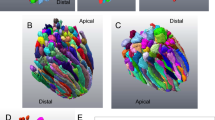Summary
The retina of Tupaia belangeri was studied by transmission electron microscopy. — Among a vast majority of cones a few typical rods have been found as a distinctly different class of photoreceptors. The outer segments of the rods measure 10 μmx1.5 μm versus 6 μmx2 μm in the cones. The repeating unit of the rod discs is 18 nm versus 22 nm in the cone discs. Rod discs tend to lose their continuity with the ciliary membrane, while cone discs do not. Rods lack the highly specialized giant mitochondria of the cone inner segment of Tupaia. The rods of Tupaia show other distinctive characters of mammalian rods as well. However, the rods of Tupaia are relatively short and do not develop a rod fiber.
Similar content being viewed by others
References
Anderson DH, Fisher SK, Steinberg RH (1978) Mammalian cones: disc shedding, phagocytosis, and renewal. Invest Ophthal Sci 17:117–133
Carter-Dawson LD, Lavail MM (1979) Rods and cones in the mouse retina. I. Structural analysis using light and electron microscopy. J Comp Neurol 188 (2):245–262
Castenholz E (1965) Über die Struktur der Netzhautmitte bei Primaten. Z Zellforsch 65:646–666
Clark Le Gros WE (1926) On the anatomy of the pen-tailed tree-shrew. Proc Zool Soc London 1179–1308
Clark Le Gros WE (1971) The antecedents of man. — Quadrangular Books, Chicago, Ill.
Cohen AI (1972) Rods and cones. In: Fuortes MGF (ed.): The handbook of sensory physiology. Vol. VII B: Physiology of photoreceptor organs, Springer, Berlin Heidelberg New York pp 67–109
DeRobertis E, Lasansky A (1958) Submicroscopic organisation of retinal cones in the rabbit. J Biophys Biochem Cytol 4:743–753
Duke-Elder WS (1932) Textbook of ophtalmology. Vol. II Kimpton, London
Haines DE, Swindler DR (1972) Comparative neuroanatomical evidence and the taxonomy of the tree shrews (Tupaia). J Hum Evol 1:407–420
Hajdu F, Hassler R, Wagner A (1982) The distribution of crossed and uncrossed optic fibers in the different layers of the lateral geniculate nucleus in the tree shrew (Tupaia glis). Anat Embryol 164:1–8
Noback CR, Berger M, Laemle LK, Shriver JE (1969) Phylogenetic aspects of the visual systems in Primates and Tupaia. Proc 2nd Internat Congr Primat. Atlanta, Vol. 3, 49–54. Karger, Basel New York
Ordy JM, Samorajski T (1968) Visual acuity and ERG-CFF in relation to the morphologic organization of the retina among diurnal and noctural primates. Vision Res 8 (9):1205–1225
Rohen JW (1962) Sehorgan. In: Hofer H, Schultz AH, Starck D (eds.): Primatologia, Handbuch der Primatenkunde, Vol. II (Teil 1) Lief. 6; Karger, Basel New York, pp 1–210
Rohen JW (1964) Das Auge und seine Hilfsorgane. In: Bargmann W (ed.): Handbuch der mikroskopischen Antomie des Menschen, Vol. III/4 Springer, Berlin
Samorajski T, Ordy JM, Keefe JR (1966) Structural organization of the retina in the tree-shrew (Tupaia glis). J Cell Biol 28:489–504
Sjöstrand F (1959) The ultrastructure of the retinal receptors of the vertebrate eye. Erg Biol 21:128–160
Stell WK (1972) The morphological organization of the vertebrate retina. In: Fuortes MGF (ed.): The handbook of sensory Physiology, Vol. VII B: Physiology of photoreceptor organs, 110–213 Springer, Berlin Heidelberg New York
Tigges J, Brooks BA, Klee MR (1967): ERG recordings of a primate cone retina (Tupaia glis). Vision Res 7:553–563
Walls GL (1942) The vertebrate eye and its adaptive radiation. Bloomfield Hills, Michigan
West RW, Dowling JE (1975) Anatomical evidence for cone and rodlike receptors in the Gray Squirrel, Ground Squirrel, and Prairie Dog retinas. J Comp Neurol 159:439–460
Wolin LR, Massopust LC (1970) Morphology of the primate retina. In: Noback CR, Montagna W (eds.): The Primate brain. Advances in Primatology Vol. I. Appleton-Century-Crofts, New York
Woollard HH (1926) Notes on the retina and lateral geniculate body in Tupaia, Tarsius, Nycticebus, and Hapale. Brain 49:77–104
Young RW (1974) Biogenesis and renewal of visual cell outer segment membranes. Exp Eye Res 18:215–223
Author information
Authors and Affiliations
Additional information
The study was supported by the Deutsche Forschungsgemeinschaft (Sonderforschungsbereich 89, Project M 1)
Rights and permissions
About this article
Cite this article
Kühne, JH. Rod receptors in the retina of Tupaia belangeri . Anat Embryol 167, 95–102 (1983). https://doi.org/10.1007/BF00304603
Accepted:
Issue Date:
DOI: https://doi.org/10.1007/BF00304603




